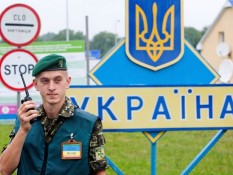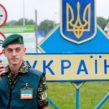
Ukraine Constrained to Declare Unilateral Ceasefire in Donbas
Publication: Eurasia Daily Monitor Volume: 11 Issue: 114
By:

On June 20, President Petro Poroshenko ordered a seven-day unilateral ceasefire by Ukrainian forces in the Donetsk and Luhansk provinces, parts of which have been seized by Russia’s proxy forces. On the same date, Poroshenko unveiled a “peace plan” in 15 points for resolving the ongoing conflict there. Poroshenko announced these initiatives from a National Guard base in the Donetsk province during his first visit there as president. He elaborated on it in his June 21 televised address to the country (president.gov.ua, June 20, 21).
During the ceasefire period, scheduled to continue until June 27, Ukrainian forces are tasked with protecting and defending the Ukraine-Russia border. In some sectors, however, Ukrainian forces shall be positioned 10 kilometers away from the border within Ukraine’s territory. Ukrainian authorities sound confident that their artillery can, from that range, stop the penetration of additional combat groups and hardware from Russia into Ukraine. In announcing the ceasefire, Poroshenko asserted that the “terrorists who fail to lay down arms will be destroyed” after the expiry of the temporary ceasefire, by June 27 (UNIAN, June 20, 22). Under the presidential order, Ukrainian “anti-terrorist forces” are only authorized to fire back if attacked; or in case of a “clear attack,” according to operational headquarters spokesman Vladyslav Seleznyov (Interfax-Ukraine, June 20), a formulation inadvertently adding to the burden of proof on the aggressed Ukraine.
Pro-Russia forces continued fighting until June 23. On that day, the Russian political leader in Donetsk, Aleksandr Borodai, announced a parallel ceasefire on behalf of the “Donetsk People’s Republic.” This group insists that their ceasefire is not a reciprocal one, but a parallel unilateral one, because Kyiv did not negotiate it with the “Donetsk People’s Republic,” i.e. did not recognize the latter. The Organization for Security and Cooperation in Europe (OSCE), however, took a first step de facto in that direction by negotiating the ceasefire with Borodai at his Donetsk office, in a room adorned with the “Donetsk People’s Republic’s” banner. The ceasefire is valid until 10 a.m. on June 27. Whether the “Luhansk People’s Republic’s” leaders have subscribed to the ceasefire seems unclear (Interfax-Ukraine, June 23, 24; Kyiv Post, June 24).
June 23 became the first day without combat actions in Ukraine’s Donetsk and Luhansk provinces since Russia exported the armed hostilities there in mid-April. The ceasefire, however, will undoubtedly allow Russia’s proxy forces a respite for regrouping and entrenching in Ukraine’s territory, possibly receiving reinforcements.
President Poroshenko and the Ukrainian government have yet to explain the sudden shift in their position. Within several days, Kyiv’s political-military objective changed from ridding Ukraine’s territory of “terrorist” forces to achieving peace. The desire for peace is presented to some extent as a goal in itself, but is also related to subsequent political negotiations in the coming weeks and months. Whether Kyiv’s hand will be stronger or weaker politically in those negotiations, if the secessionist forces remain standing by that time, is something that remains to be seen.
Kyiv’s exhortations to those “terrorists” to take advantage of the ceasefire for disarming voluntarily sound naive, despite the amnesty being proposed to lesser offenders among those forces. By the same token, Kyiv’s warnings of renewed military action in the event of non-compliance after June 27 do not sound credible. The secessionist forces will undoubtedly view Ukraine’s ceasefire initiative as a sign of weakness and a concession to Russia. President Vladimir Putin had demanded a ceasefire insistently in recent weeks, while steadily escalating the hostilities with more paramilitary forces and combat hardware from Russia.
This being the background to Kyiv’s unilateral move, it seems unlikely that Ukraine would re-commence its military actions after June 27. The Kremlin would undoubtedly expect Ukraine to prolong the ceasefire, and would denounce any Ukrainian resumption of military actions as a criminal act before the world. Whether Western leaders would stand by Ukraine in that eventuality is far from assured. Barring egregious secessionist provocations that are seen as such by the world, Ukraine will probably have to desist from military actions after June 27, even as Russia’s proxy forces remain positioned inside Ukraine’s territory.
Almost unaided by the West, Ukraine has not been able from its own resources to keep up with Russia’s escalation at the level this has reached. Instead of Russia “de-escalating” this war (the Western leaders’ idle hope without serious action), Ukraine finds itself constrained to “de-escalate” its own legitimate defense through this unilateral ceasefire.
The Kremlin welcomes this ceasefire for a number of reasons. Militarily, the ceasefire at this time plays in favor of the Kremlin’s protégés. Politically, it gives the Kremlin and “neutral” players such as the OSCE the opportunity to equate Russia’s proxy forces with Ukraine’s legitimate forces as “parties to the conflict.” On the international level, the ceasefire works to exempt Russia from any responsibility for this conflict. Russia has initiated a multi-dimensional war against Ukraine; but the ceasefire has been negotiated with Russia’s protégés in a co-equal position with Ukraine’s legitimate forces. Such equivalence bolsters Russia’s misrepresentation of this conflict as an internal Ukrainian conflict (see EDM, June 17). If successful, this misrepresentation can usher in another, protracted “frozen conflict”–type situation, with two “internal parties to the conflict” negotiating forever under some international mediation, including Russia as an influential external arbiter.




